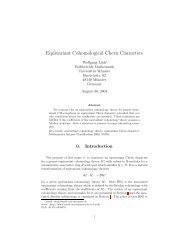Connes-Chern Character for Manifolds with Boundary and ETA ...
Connes-Chern Character for Manifolds with Boundary and ETA ...
Connes-Chern Character for Manifolds with Boundary and ETA ...
You also want an ePaper? Increase the reach of your titles
YUMPU automatically turns print PDFs into web optimized ePapers that Google loves.
CONNES-CHERN CHARACTER AND <strong>ETA</strong> COCHAINS 75<br />
For an operator T in a Hilbert space H we denote by ‖T ‖ p the p–th Schatten norm.<br />
To avoid confusions the letter p will not be used <strong>for</strong> Sobolev orders. Note that the<br />
operator norm of T in H coincides <strong>with</strong> ‖T ‖ ∞ .<br />
Proposition B.1. Let A, B ∈ Ψ • (M, W ) be pseudodifferential operators of order a, b<br />
<strong>with</strong> compact support. 1<br />
1. If k > (dim M)/4 + a/2 then A(D 2 − λ) −k , (D 2 − λ) −k A are Hilbert–Schmidt<br />
operators <strong>for</strong> λ ∉ spec D 2 <strong>and</strong> we have<br />
‖A(D 2 − λ) −k ‖ 2 = O(|λ| a/2+(dim M)/4−k+0 ), as λ → ∞ in Λ. (B.1)<br />
The same estimate holds <strong>for</strong> ‖(D 2 − λ) −k A‖ 2 .<br />
2. If k > (dim M + a + b)/2 then A(D 2 − λ) −k B is of trace class <strong>for</strong> λ ∉ spec D 2 <strong>and</strong><br />
‖A(D 2 − λ) −k B‖ 1 = O(|λ| (dim M+a+b)/2−k+0 ), as λ → ∞ in Λ. (B.2)<br />
3. Denote by π 1 , π 2 : M × M → M the projection onto the first resp. second factor<br />
<strong>and</strong> assume that π 2 (supp A) ∩ π 1 (supp B) = ∅. Then A(D 2 − λ) −k B is a trace class<br />
operator <strong>for</strong> any k ≥ 1 <strong>and</strong><br />
‖A(D 2 − λ) −k B‖ 1 = O(|λ| −∞ ), as λ → ∞ in Λ. (B.3)<br />
Proof. 1. Sobolev embedding <strong>and</strong> elliptic regularity implies that <strong>for</strong> f ∈ L 2 (M; W ) the<br />
section A(D 2 − λ) −k f is continuous. Moreover, <strong>for</strong> r > dim M/2, |λ| ≥ |λ 0 |, <strong>and</strong> x in<br />
the compact set supp A =: K<br />
‖ ( A(D 2 − λ) −k f ) (x)‖ ≤ C‖(D 2 − λ) −k ‖ a+r,K<br />
≤ C‖(D 2 + I) (a+r)/2 (D 2 − λ) −k f‖ 0<br />
≤ C|λ| −k+(a+r)/2 ‖f‖.<br />
For the Schwartz–kernel this implies the estimate<br />
∫<br />
‖A(D 2 − λ) −k (x, y)‖ 2 d vol(y) ≤ C|λ| −2k+a+r ,<br />
sup<br />
x∈supp A<br />
M<br />
<strong>and</strong> since A has compact support, integration over x yields<br />
‖A(D 2 − λ) −k ‖ 2 2<br />
∫ ∫<br />
≤ ‖A(D 2 − λ) −k (x, y)‖ 2 d vol(x)d vol(y)<br />
supp A<br />
M<br />
≤ C|λ| −2k+a+r ,<br />
(B.4)<br />
(B.5)<br />
(B.6)<br />
proving the estimate (B.1). The estimate <strong>for</strong> (D 2 −λ) −k A follows by taking the adjoint.<br />
2. The second claim follows from the first one using the Hölder inequality.<br />
3. To prove the third claim we choose cut–off functions ϕ, ψ ∈ C ∞ 0 (M) <strong>with</strong> ϕ = 1<br />
on π 2 (supp A), ψ = 1 on π 1 (supp B) <strong>and</strong> supp ϕ ∩ supp ψ = ∅.<br />
1 This means that their Schwartz kernels are compactly supported in M × M.

















